 Toyota Camry XV30 (2002–2006) Service ManualPower steering
Toyota Camry XV30 (2002–2006) Service ManualPower steering
Power steering system
Power steering system
ON−VEHICLE INSPECTION
1. INSPECT DRIVE BELT
a. Visually check the belt for excessive wear, frayed cords, etc.
If any defect is found, replace the drive belt.
HINT: Cracks on the rib side of a belt are considered acceptable. If the missing chunks from the ribs are found on the belt, it should be replaced.
2. BLEED POWER STEERING SYSTEM
-
Check the fluid level.
-
Jack up the front of the vehicle and support it with the stands.
-
Turn the steering wheel.
1. With the engine stopped, turn the wheel slowly from lock to lock several times.
-
Lower the vehicle.
-
Start the engine.
1. Run the engine at idle for a few minutes.
f. Turn the steering wheel.
-
With the engine idling, turn the wheel to left or right full lock position and keep it there for 2 − 3 seconds, then turn the wheel to the opposite full lock position and keep it there for 2 − 3 seconds.
-
Repeat 1. several times.
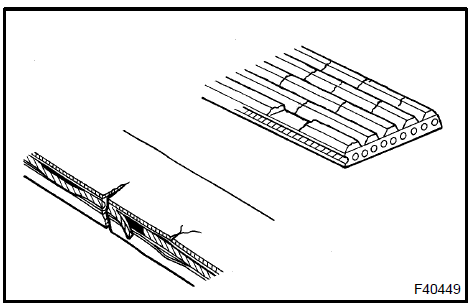
-
Stop the engine.
-
Check for forming or emulsification.
Especially, if the system has to be bled twice because of foaming or emulsification, check for fluid leaks in the system.
i. Check the fluid level.
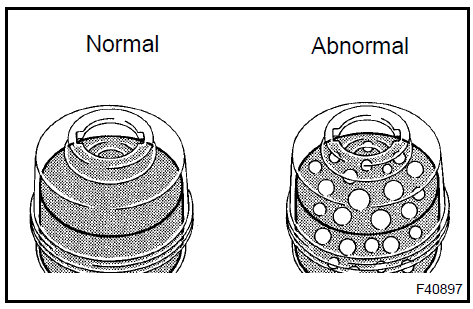
3. CHECK FLUID LEVEL
-
Keep the vehicle level.
-
With the engine stopped, check the fluid level in the oil reservoir.
If necessary, add fluid.
Fluid: ATF DEXRON® II or III
HINT: Check that the fluid level is within the HOT LEVEL range on the reservoir cap. If the fluid is cold, check that it is within the COLD LEVEL range
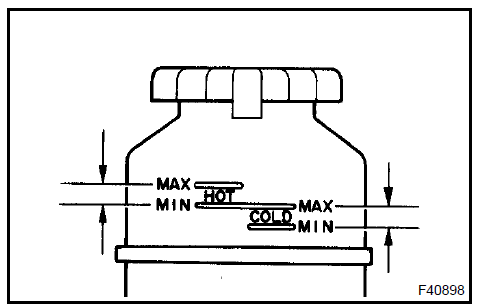
-
Start the engine and run it at idle.
-
Turn the steering wheel from lock to lock several times to raise fluid temperature.
Fluid temperature: 75 − 80°C (167 − 176°F)
-
Check for foaming or emulsification.
If foaming or emulsification is identified, bleed the power steering system.
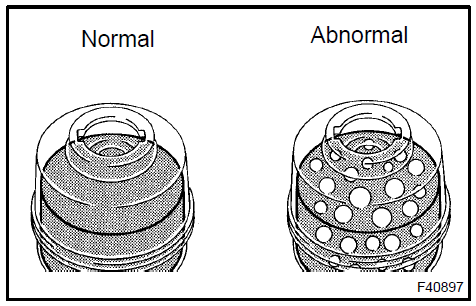
-
With the engine idling, measure the fluid level in the oil reservoir.
-
Stop the engine.
-
Wait a few minutes and remeasure the fluid level in the oil reservoir.
Maximum fluid level rise: 5 mm (0.20 in.)
If a problem is found, bleed the power steering system.
i. Check the fluid level.
4. CHECK STEERING FLUID PRESSURE
-
Disconnect the pressure feed tube from the rack & pinion power steering gear assy.
-
Connect SST, as shown in the illustration.
SST 09640−10010 (09641−01010, 09641−01020, 09641−01030)
NOTICE: Check that the valve of the SST is in the open position.
-
Bleed the power steering system.
-
Start the engine and run it at idle.
-
(Turn the steering wheel from lock to lock several times to raise fluid temperature.
Fluid temperature: 75 − 80 °C (167 − 176 °F)
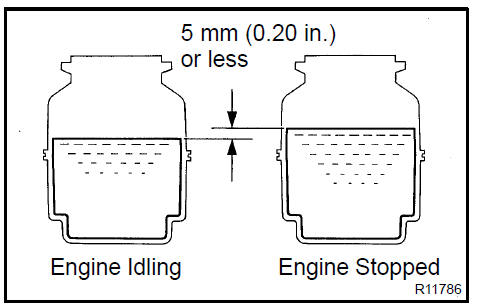
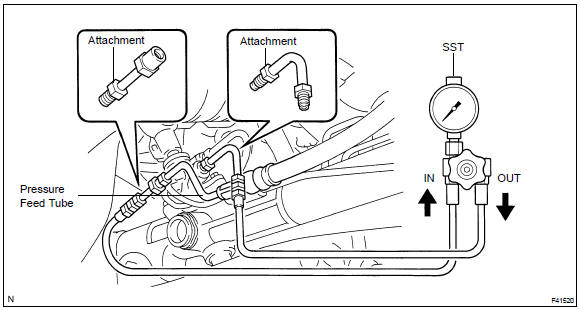
f. With the engine idling, close the valve of the SST and observe the reading on the SST.
Fluid pressure: 7,800 − 8,300 kPa (80 − 85 kgf/cm2, 1,138 − 1,209 psi)
NOTICE:
-
Do not keep the valve closed for more than 10 seconds.
-
Do not let the fluid temperature become too high.
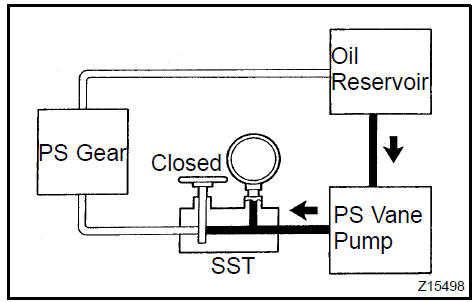
-
With the engine idling, open the valve fully.
-
Measure the fluid pressure at engine speeds of 1,000 rpm and 3,000 rpm.
Fluid pressure difference: 490 kPa (5 kgf/cm2, 71 psi) or less
NOTICE: Do not turn the steering wheel.
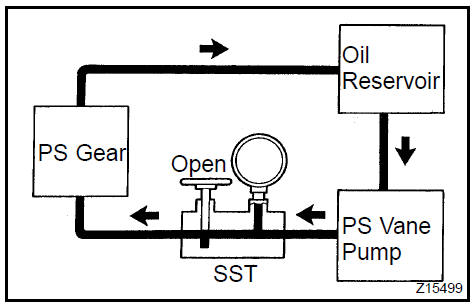
i. With the engine idling and valve fully opened, turn the steering wheel to full lock position.
Fluid pressure: 7,800 − 8,300 kPa (80 − 85 kgf/cm2, 1,138 − 1,209 psi)
NOTICE:
-
Do not maintain lock position for more than 10 seconds.
-
Do not let the fluid temperature become too high.
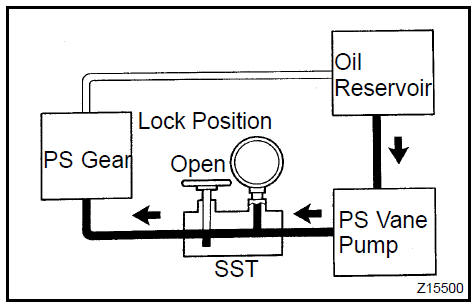
-
Disconnect the SST.
SST 09640−10010 (09641−01010, 09641−01020, 09641−01030)
-
Connect the pressure feed tube to the rack & pinion power steering gear assy.
-
Bleed the power steering system.
5. CHECK STEERING EFFORT
-
Center the steering wheel assy.
-
Remove the horn button assy
-
Start the engine and run it at idle.
-
Using a torque wrench, measure the steering effort in both directions.
Steering effort (Reference): 6 N·m (60 kgf·cm, 53 in.·lbf) or less
HINT: Take the tire type, pressure and contact surface into consideration before making your diagnosis.
-
Install the steering wheel assy set nut.
Torque: 50 N·m (510 kgf·cm, 37 ft·lbf)
-
Install the horn button assy
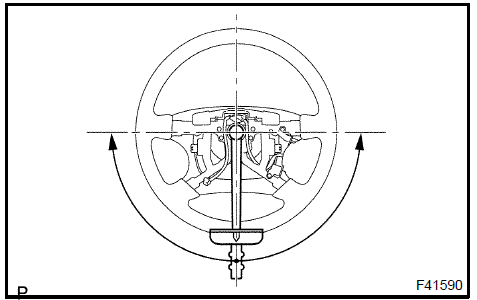 Check steering effort
Check steering effort
Power steering system
Vane pump assy (1MZ−FE/3MZ−FE)
Power steering system
Rack & pinion power steering gear assy
Power steering system
Vane pump assy (2AZ−FE)
Toyota Camry XV30 (2002–2006) Service Manual
- Introduction
- Audio & visual system
- Automatic transmission / trans
- Brake
- Clutch
- Communication system
- Cooling
- Cruise control
- Drive shaft / propeller shaft
- Emission control
- Engine control system
- Engine hood/door
- Engine mechanical
- Exhaust
- Exterior/interior trim
- Front suspension
- Fuel
- Heater & air conditioner
- Ignition
- Instrument panel/meter
- Intake
- Lighting
- Lubrication
- Manual transmission/transaxle
- Parking brake
- Power steering
- Rear suspension
- Seat
- Service specifications
- Sliding roof/convertible
- Starting & charging
- Steering column
- Supplemental restraint system
- Theft deterrent & door lock
- Tire & wheel
- Windshield/windowglass/mirror
- Wiper & washer
- Wiring
